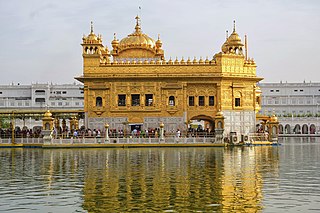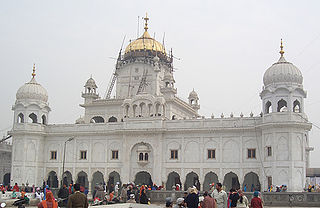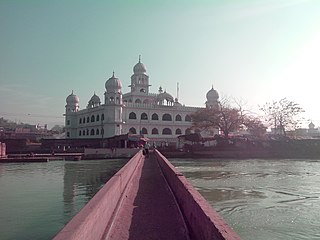A gurdwara or gurudwara is a place of assembly and worship for Sikhs. Sikhs also refer to gurdwaras as Gurdwara Sahib. People from all faiths are welcomed in gurdwaras. Each gurdwara has a Darbar Sahib where the Guru Granth Sahib is placed on a takhat in a prominent central position. Any congregant may recite, sing, and explain the verses from the Guru Granth Sahib, in the presence of the rest of the congregation.

Guru Tegh Bahadur was the ninth of ten gurus who founded the Sikh religion and was the leader of Sikhs from 1665 until his beheading in 1675. He was born in Amritsar, Punjab, India in 1621 and was the youngest son of Guru Hargobind, the sixth Sikh guru. Considered a principled and fearless warrior, he was a learned spiritual scholar and a poet whose 115 hymns are included in the Guru Granth Sahib, which is the main text of Sikhism.

Dhubri District (Pron:ˈdʊbri) is an administrative district in the Indian state of Assam. The district headquarters are located at Dhubri town which is situated at ~290 km from Guwahati. This was also the headquarters of erstwhile undivided Goalpara district which was created in 1876 by the British government. In 1983, Goalpara district was divided into four districts and Dhubri is one among those. Dhubri district is one among the many Muslim-majority districts of Assam. In 2016, Dhubri was divided again to form South Salmara-Mankachar District.

Anandpur Sahib, also referred simply as Anandpur, is a city in Rupnagar district (Ropar), on the edge of Shivalik Hills, in the Indian state of Punjab. Located near the Sutlej River, the city is one of the most sacred places in Sikhism, being the place where the last two Sikh Gurus, Guru Tegh Bahadur and Guru Gobind Singh, lived. It is also the place where Guru Gobind Singh founded the Khalsa Panth in 1699. The city is home to Takhat Sri Kesgarh Sahib, the third of the five Takhts in Sikhism.

Dhubri is an old town and headquarter of Dhubri district in Indian state of Assam. It is an old town on the bank of the Brahmaputra river, with historical significance. In 1883, the town was first constituted as a Municipal Board under the British regime. It is situated about 277.4 kilometres (172 mi) west from Dispur, the state capital of Assam.

Goindwal, also known as Goindwal Sahib and alternatively transliterated as Goindval, is located in the Taran Taran district of the Majha region of Punjab, India about 23 km from Tarn Taran Sahib. In the 16th century it became an important center for the Sikh religion during the Guruship of the Guru Amar Das Ji. Goindwal is on the banks of the river Beas and is one of the focal points of small scale industries of Tarn Taran district.

Gurdwara Sis Ganj Sahib is one of the nine historical Gurdwaras in Delhi. It was first constructed in 1783 as a small shrine by Baghel Singh to commemorate the martyrdom site of the ninth Sikh Guru, Guru Tegh Bahadur and was probably expanded after Indian Rebellion of 1857 or after Partition of India. Before its construction the Mughal Kotwali was situated here. After the Indian Rebellion of 1857 the Mughal Kotwali was demolished by the British and the land was given to the Sikhs as the Maharaja of Patiala and other Sikh soldiers helped the British to defeat the Mughal soldiers by providing large numbers of ammunition and soldiers. Its current building was made by Rai Bahadur Narain Singh a contractor who build most of roads in Lutyens New Delhi construction under British Rule. Situated in Chandni Chowk in Old Delhi, it marks the site where the ninth Sikh Guru was beheaded on the orders of the Mughal emperor Aurangzeb on 11 November 1675. The Sikh regiment of the Indian army salute the Sis Ganj Gurudwara before saluting the president of India since 1979, the only instance of saluting twice in the Republic Day parade by a regiment of Indian army.

Bhai Mati Das, along with his younger brother Bhai Sati Das were martyrs of early Sikh history. Bhai Mati Das, Bhai Dayala, and Bhai Sati Das were executed at a kotwali (police-station) in the Chandni Chowk area of Delhi, under the express orders of Emperor Aurangzeb just before the martyrdom of Guru Tegh Bahadur. Bhai Mati Das was executed by being bound between two pillars and cut in two.

Indian Sikhs number approximately 21 million people and account for 1.7% of India's population as of 2011, forming the country's fourth-largest religious group. The majority of the nation's Sikhs live in the northern state of Punjab, which is the only Sikh-majority administrative division in the world.

Bhai Sati Das along with his elder brother Bhai Mati Das were martyrs of early Sikh history. Bhai Sati Das, Bhai Mati Das and Bhai Dyal Das were all executed at kotwali (police-station) in the Chandni Chowk area of Delhi, under the express orders of emperor Aurangzeb just prior to the martyrdom of Guru Tegh Bahadur. Bhai Sati Das was executed by the means of being wrapped in cotton wool soaked in oil and set on fire.
Lanka is a town located in Hojai District of Assam, and a town area committee with 11 wards. It serves as a trade and commerce hub for nearby areas such as Udali, Nokhuti, Laskar Pather, Karikhana, Kheroni, Dablong, and Doiyong sides. It is connected to other cities/states such as Guwahati by NH27.

The Delhi Sikh Gurdwara Management Committee (DSGMC) is organization in India responsible for the management of Gurdwaras, Sikh places of worship in Delhi. It also manages various educational institutions, hospitals, old age homes, libraries and other charitable institutions in Delhi. It is headquartered in Gurdwara Rakab Ganj Sahib, near Parliament House. Currently, the president of DSGMC is Harmeet Singh Kalka.

Gurdwara Dukh Nivaran Sahib is situated in what used to be the village of Lehal, now part of Patiala city.
Gurdwara Pahila Bara, commonly known as Gurdwara Gai Ghat, is a holy Gurdwara of Sikh religion. It is located in the city of Patna, Bihar, India and dedicated to Guru Nanak Dev. The Gurdwara is part of "Guru Circuit" - A Government of Bihar initiative connecting important Sikh religious destinations in Bihar to attract more pilgrims.

Kiratpur, also known as Kiratpur Sahib, is a town in Rupnagar district of Punjab, India. The town is the location of the Gurdwara Patal Puri where many Sikhs take ashes of their deceased.

Hazur Sahib, also known as Takht Sachkhand Sri Hazur Abchalnagar Sahib, is one of the five takhts in Sikhism. The gurdwara was built between 1832 and 1837 by Maharaja Ranjit Singh (1780–1839). It is located on the banks of the Godavari River at the city of Nanded in the state of Maharashtra, India.
A takht, or taḵẖat, literally means a throne or seat of authority and is a spiritual and temporal centre of Sikhism. There are five takhts, which are five gurudwaras that have a very special significance for the Sikh community. Three are located in Punjab whilst the remaining two are located outside of it.

Sikhism in Bangladesh has an extensive heritage and history, although Sikhs had always been a minority community in Bengal. Their founder, Guru Nanak visited a number of places in Bengal in the early sixteenth century where he introduced Sikhism to locals and founded numerous establishments. In its early history, the Sikh gurus despatched their followers to propagate Sikh teachings in Bengal and issued hukamnamas to that region. Guru Tegh Bahadur lived in Bengal for two years, and his successor Guru Gobind Singh also visited the region. Sikhism in Bengal continued to exist during the colonial period as Sikhs found employment in the region, but it declined after the partition in 1947. Among the eighteen historical gurdwaras in Bangladesh, only five are extant. The Gurdwara Nanak Shahi of Dhaka is the principal and largest gurdwara in the country. The Sikh population in the country almost entirely consists of businessmen and government officials from the neighbouring Republic of India.

The Akal Sena was the Sikh military force established by the sixth Sikh Guru, Guru Hargobind. It was the first standing Sikh army. It was also known as the Akali Dal.















